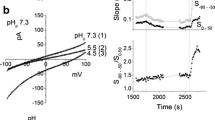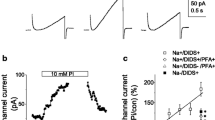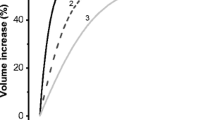Abstract
The calcium indicator fura-2 was used to study the effect of hypotonic solutions on the intracellular calcium concentration, [Ca2+] i , in a human osteoblast-like cell line. Decreasing the tonicity of the extracellular solution to 50% leads to an increase in [Ca2+] i from ∼150 nm up to 1.3 μm. This increase in [Ca2+] i was mainly due to an influx of extracellular Ca2+ since removing of extracellular Ca2+ reduced this increase to ∼250 nm. After cell swelling most of the cells were able to regulate their volume to the initial level within 800 sec. The whole-cell recording mode of the patch-clamp technique was also used to study the effect of an increase in [Ca2+] i on membrane currents in these cells. An increase in [Ca2+] i revealed two types of Ca2+-activated K+ channels, K(Ca) channels. Current through both channel types could not be observed below voltage of +80 mV with [Ca2+] i buffered to 100 nm or less. With patch-electrodes filled with solutions buffering [Ca2+] i to 10 μm both channels types could be readily observed. The activation of the first type was apparently voltage-independent since current could be observed over the entire voltage range used from −160 to +100 mV. In addition, the current was also blocked by charybdotoxin (CTX). The second type of K(Ca) channels in these cells could be activated with depolarizations more positive than −40 mV from a holding potential of −80 mV. This type was blocked by CTX and paxilline. Adding paxilline to the extracellular solution inhibited regulatory volume decrease (RVD), but could not abolish RVD. We conclude that two K(Ca) channel types exist in human osteoblasts, an intermediate conductance K(Ca) channel and a MaxiK-like K(Ca) channel. MaxiK channels might get activated either directly or by an increase in [Ca2+] i elicited through hypotonic solutions. In combination with the volume-regulated Cl− conductance in the same cells this K+ channel seems to play a vital role in volume regulation in human osteoblasts.
Similar content being viewed by others
Author information
Authors and Affiliations
Additional information
Received: 8 February 2000/Revised: 13 July 2000
Rights and permissions
About this article
Cite this article
Weskamp, M., Seidl, W. & Grissmer, S. Characterization of the Increase in [Ca2+] i During Hypotonic Shock and the Involvement of Ca2+-activated K+ Channels in the Regulatory Volume Decrease in Human Osteoblast-like Cells. J. Membrane Biol. 178, 11–20 (2000). https://doi.org/10.1007/s002320010010
Published:
Issue Date:
DOI: https://doi.org/10.1007/s002320010010




